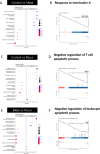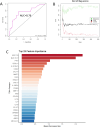MUC16 as a serum-based prognostic indicator of prometastatic gastric cancer
- PMID: 38956143
- PMCID: PMC11220052
- DOI: 10.1038/s41598-024-64798-8
MUC16 as a serum-based prognostic indicator of prometastatic gastric cancer
Abstract
Metastatic gastric cancer (GC) presents significant clinical challenges due to its poor prognosis and limited treatment options. To address this, we conducted a targeted protein biomarker discovery study to identify markers predictive of metastasis in advanced GC (AGC). Serum samples from 176 AGC patients (T stage 3 or higher) were analyzed using the Olink Proteomics Target panels. Patients were retrospectively categorized into nonmetastatic, metastatic, and recurrence groups, and differential protein expression was assessed. Machine learning and gene set enrichment analysis (GSEA) methods were applied to discover biomarkers and predict prognosis. Four proteins (MUC16, CAIX, 5'-NT, and CD8A) were significantly elevated in metastatic GC patients compared to the control group. Additionally, GSEA indicated that the response to interleukin-4 and hypoxia-related pathways were enriched in metastatic patients. Random forest classification and decision-tree modeling showed that MUC16 could be a predictive marker for metastasis in GC patients. Additionally, ELISA validation confirmed elevated MUC16 levels in metastatic patients. Notably, high MUC16 levels were independently associated with metastatic progression in T3 or higher GC. These findings suggest the potential of MUC16 as a clinically relevant biomarker for identifying GC patients at high risk of metastasis.
Keywords: Gastric cancer; MUC16; Metastasis; Olink; Serum-based prognostic marker.
© 2024. The Author(s).
Conflict of interest statement
The authors declare no competing interests.
Figures





References
MeSH terms
Substances
Grants and funding
LinkOut - more resources
Full Text Sources
Medical
Research Materials
Miscellaneous

